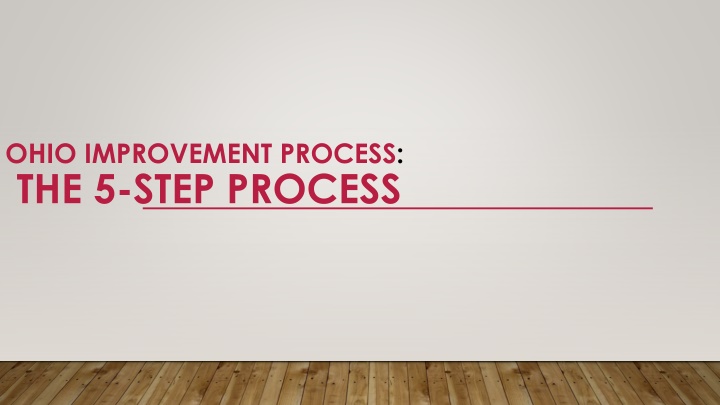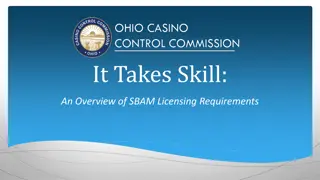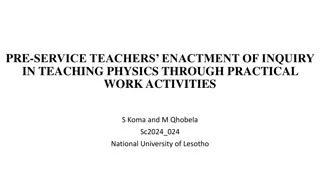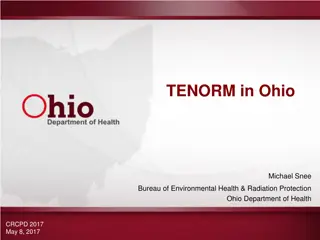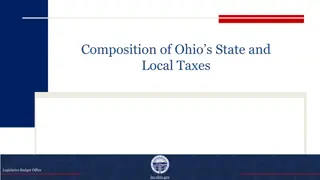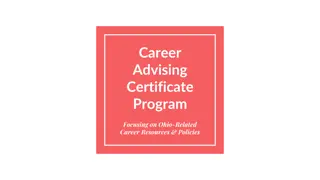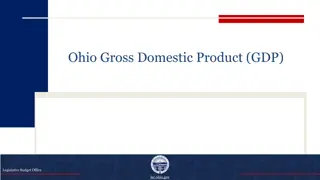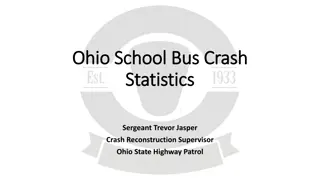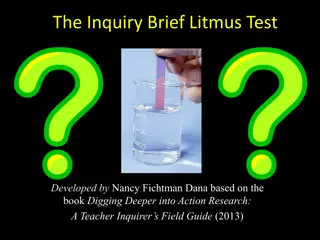The Ohio Improvement Process: 5-Step Cycle of Inquiry
Dive into the Ohio Improvement Process and how teachers can utilize the 5-step cycle of inquiry, understand the roles of different teams, and explore the process of continuous improvement in educational settings.
Download Presentation

Please find below an Image/Link to download the presentation.
The content on the website is provided AS IS for your information and personal use only. It may not be sold, licensed, or shared on other websites without obtaining consent from the author.If you encounter any issues during the download, it is possible that the publisher has removed the file from their server.
You are allowed to download the files provided on this website for personal or commercial use, subject to the condition that they are used lawfully. All files are the property of their respective owners.
The content on the website is provided AS IS for your information and personal use only. It may not be sold, licensed, or shared on other websites without obtaining consent from the author.
E N D
Presentation Transcript
OHIO IMPROVEMENT PROCESS: THE 5-STEP PROCESS
OBJECTIVES TEACHERS WILL: Learn about the Ohio Improvement Process. Learn how to use the 5 Step Cycle of Inquiry and how it is situated within the Ohio Improvement Process. Learn about the components that make an efficient TBT.
WHY THE OHIO IMPROVEMENT PROCESS? ODE has revised it s guidance to school districts regarding Continuous Improvement resulting in the Ohio Improvement Process. The revisions occurred because of: Changes in technology New learning about the effective use of relevant data More concrete knowledge about what works and how to distribute leadership in districts and schools to improve instructional practice and student performance. www.education.ohio.gov
What is the Ohio Improvement Process? www.education.ohio.gov
WHO IS PART OF THE OIP? District Leadership Team Building Leadership Team Teacher Based Team Teacher Every person in the district is part of the OIP.
WHAT ARE THE ROLES OF THESE GROUPS? Teacher Based Team District Leadership Team Building Leadership Team Train TBT in 5-step process Collect Data Monitor TBT Analyze results Uses the data to provide supports for TBT Asses quality of TBT implementation Choose a strategy and provide instruction Use BLT data to provide support Provide TBT information for DLT Assess Collect Data (The 5-step Process) www.education.ohio.gov
The 5-Step Process of Inquiry: This is embedded in step 3 of the OIP and is completed by TBTs. www.education.ohio.gov
The 5-Step Process of Inquiry: Another view: Teacher Based Teams will: 1. Collect Data 2. Analyze Student Work 3. Establish shared strategies for change 4. Implement changes 5. Collect, chart, and analyze data Notice how step 1 and step 5 are similar. The beginning and the end of the cycle are interchangeable. www.education.ohio.gov
LETS GET STARTED WHEN TBT S MEET, YOU WILL RECORD YOUR MINUTES ON THE MEETING AGENDA AND MINUTES TEMPLATE. (SEE HANDOUT.) This is what will be turned in to the BLT upon completion. www.education.ohio.gov
LETS GET STARTED YOU WILL ALSO USE THIS RECORDING AND REPORTING MONITORING DATA TEMPLATE DURING THE TBT PROCESS. (SEE HANDOUT.) www.education.ohio.gov
STEP 1 DATA COLLECTION: COLLECT AND CHART DATA TO IDENTIFY HOW STUDENTS ARE PERFORMING/PROGRESSING During the first TBT meeting, you will decide what will be the focus of your 5-step process cycle. This should reflect one of your teaching standards. This should be a topic you think is an area in need of improvement. Give a common pre-assessment to all students. www.education.ohio.gov
STEP 1 DATA COLLECTION: COLLECT AND CHART DATA TO IDENTIFY HOW STUDENTS ARE PERFORMING/PROGRESSING An example focus could be Kindergarten LA: Associate the long and short with common spellings for the 5 major vowels.
STEP 1 DATA COLLECTION: The pre-assessment could look like this:
STEP 1 DATA COLLECTION: TAKE 5 MINUTES In your TBT group, discuss what you could use a focus for your 5-step cycle and what assessment you would use.
STEP 1 DATA COLLECTION: COLLECT AND CHART DATA TO IDENTIFY HOW STUDENTS ARE PERFORMING/PROGRESSING The next meeting of your TBT will rely on the following: Data is ready and brought by all teachers. Item analysis is complete. Includes students tested/proficient and not proficient. Subgroup data is reported. Determine benchmark score for grouping criteria. www.education.ohio.gov
STEP 1 DATA COLLECTION: TAKE 5 MINUTES In your TBT group, discuss what criteria you would use to determine levels of proficiency.
STEP 1: DATA COLLECTION Chart you data prior to this next meeting on this Recording and Reporting Data Template. www.education.ohio.gov
STEP 1: DATA COLLECTION A completed example: www.education.ohio.gov
STEP 1 DATA COLLECTION At the TBT meeting, aggregate all teacher s data onto the TBT 5-step Process form. www.education.ohio.gov
STEP 1 DATA COLLECTION www.education.ohio.gov
STEP 2 ANALYZE STUDENT WORK SPECIFIC TO THE DATA ASK YOURSELVES THESE QUESTIONS: What did students do well and why? What did students not do well on and why? Were there common errors, misconceptions, or urgent needs? Are there patterns or trends? Prioritize needs. www.education.ohio.gov
STEP 2 ANALYZE STUDENT WORK SPECIFIC TO THE DATA TAKE 5 MINUTES In your TBT group, use the strengths and weaknesses we just discussed and report these using the TBT 5-Step Template as seen here. www.education.ohio.gov
STEP 3 ESTABLISH SHARED EXPECTATIONS FOR IMPLEMENTING SPECIFIC CHANGES IN THE CLASSROOM How will students be grouped for instruction? What differentiated strategies will be used? When will this instruction happen? What support/training in a specific strategy is needed? Determine length/frequency of instruction. www.education.ohio.gov
STEP 3 www.education.ohio.gov
STEP 3 ESTABLISHING SHARED EXPECTATIONS FOR IMPLEMENTING SPECIFIC CHANGES IN THE CLASSROOM: TAKE 5 MINUTES In you TBT group, fill out the intervention strategies you would use for the groupings students as listed on the previous screen and your handout.
STEP 3 ESTABLISHING SHARED EXPECTATIONS FOR IMPLEMENTING SPECIFIC CHANGES IN THE CLASSROOM: Classroom observations may occur. Demonstrations Co-teaching Modeling
STEP 3 A COMPLETED STEP 3 TBT REPORTING FORM: www.education.ohio.gov
STEP 4 IMPLEMENT CHANGES CONSISTENTLY ACROSS THE CLASSROOM What will be observed in the classrooms? What will the teacher be doing? What will the students be doing? www.education.ohio.gov
STEP 4 www.education.ohio.gov
STEP 4 IMPLEMENT CHANGES CONSISTENTLY ACROSS ALL CLASSROOMS TAKE 5 MINUTES In you TBT group, fill in the TBT 5-Step Process Template aggregating the data from the implementation/assessment form. www.education.ohio.gov
STEP 5 COLLECT, CHART, AND ANALYZE POST ASSESSMENT DATA Did you notice this is similar to Step 1? This creates the CYCLE of inquiry.
STEP 5 COLLECT, CHART, AND ANALYZE POST ASSESSMENT DATA Everyone comes with assessments scored and data ready. Best practices shared from classroom teachers with high student results on post-test. Include pre data and post data for all students (and any subgroups). Use same chart from Step 1 to collect/record data www.education.ohio.gov
STEP 5 COLLECT, CHART, AND ANALYZE POST ASSESSMENT DATA www.education.ohio.gov
COLLECT, CHART, AND ANALYZE POST ASSESSMENT DATA www.education.ohio.gov
STEP 5 COLLECT, CHART, AND ANALYZE POST ASSESSMENT DATA www.education.ohio.gov
STEP 5 COLLECT, CHART, AND ANALYZE POST ASSESSMENT DATA After all data is compiled and analyzed, ask yourself: What strategies and practices worked well? What did not work? What did we do to amend our goals when needed? Do we, as staff, need assistance in any area to make our teaching more effective?
AND THATS THE 5-STEP PROCESS. QUESTIONS? THANKS FOR YOUR ATTENTION. www.education.ohio.gov
REFERENCES Green, R.L. (2017). Practicing the Art of Leadership: A Problem-Based Approach to Implementing the Professional Standards for Educational Leaders (5th ed.).New York, NY: Pearson Ed. Ohio Department of Education, Ohio Improvement Process (OIP) Guide. (2012). Facilitating districtwide improvement in instructional practices and student performance. Retrieved September 22, 2017 from www.ohio.gov. Resource 21C, TBT 5-Step Process Meeting Agenda and Minutes Template. (2016). Retrieved September 22, 2017 from www.ohio.gov. Resource 25A, Recording and Reporting Monitoring Data Template: TBT 5-Step Process. (2016). Retrieved September 22, 2017 from www.ohio.gov.
REFLECTION ON LEADERSHIP THEORY In Practicing the Art of Leadership, Green (2017) states that the principal should assume the role of instructional leader and be willing to be held accountable for the academic achievement of all students (p. 236). This is a serious charge and momentous undertaking for one person. As principal, I will have a large task on my hands. As Green (2017) continues, to fulfill this role, the principal needs to establish learning communities, build capacity for change, and identify the positive and negative forces that impact the change process (p.236). As principal, I must work with others by preparing them to change their way of looking at certain aspects of education. An action that I can take to help with the change process includes employing the participatory style of leadership. By allowing others such as teachers, parents, and community members to participate in leadership, this helps build the capacity for change. When all stakeholders are invited to participate, the change will be more widely accepted than if a directive were to come from the top down (Green, 2013). By having teachers participate in DLTs, BLTs, and TBTs, they become part of the leadership and are, therefore, more accepting of the changes that need to occur.
